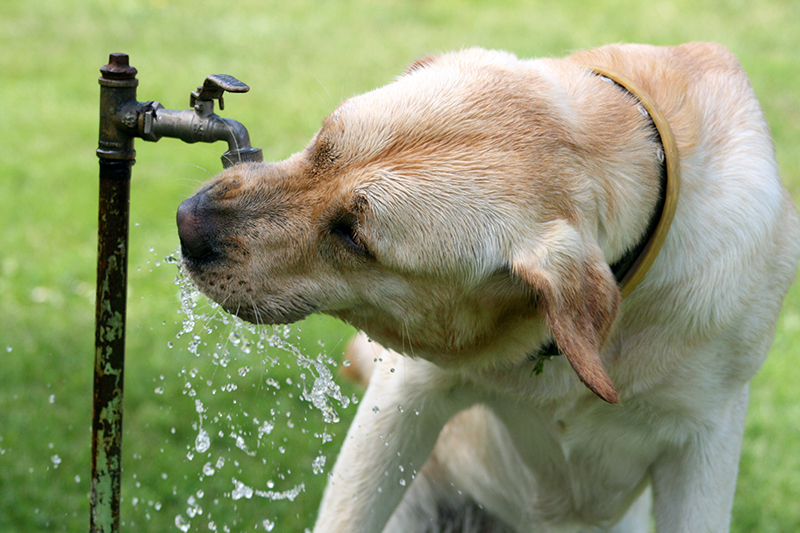Your dog’s endocrine system needs to be functioning well to avoid serious health issues, says Vicky Payne.
The endocrine organs produce hormones, which regulate how the body works. The organs are the pineal gland, the pituitary gland, the thyroid and parathyroid glands, the adrenal glands, the endocrine pancreas, and the ovaries or testes. Malfunction of these glands can have serious health consequences for your dog and are common reasons for pets to present to their vet.
Signs of disease
I had my suspicions about Bertie Cloud (known as BC) as soon as he walked into the consulting room. He was a new patient having recently moved to the area and was booked in for his vaccinations. BC is a Bichon Frise, but his lovely white hair was very thin down both his sides, and he had a big round belly.
I asked his owner a few questions and yes, he was drinking more than he used to, and seemed to be panting a lot on his walks. I was suspicious that BC had Cushing’s disease. Cushing’s disease, properly called hyperadrenocorticism, is the result of the adrenal glands producing too much of the steroid cortisol. It can be caused either by a tiny tumour in the pituitary gland, or a tumour in the adrenal gland. Cushing’s disease can be tricky to diagnose, and I discussed the blood tests that we would need to do to get a diagnosis for BC. We were also able to do a scan of his adrenal glands, which showed that, like 80 per cent of dogs, his Cushing’s was caused by an excess of the hormone ACTH being produced by his pituitary gland. His treatment is a capsule, which he takes once a day. Luckily BC is insured as regular blood tests are needed to check that the medication is working, but not dropping his cortisol levels too low. BC’s hair has started to regrow, and he is livelier.
Increased thirst may be a sign of Cushing’s disease.
Difficult to diagnose
Sabre, the German Shepherd, has the opposite problem and was more difficult to diagnose. She had
a history of episodes of vomiting and weakness that got better with a drip and supportive care. One weekend she had the same symptoms but much worse and having been to a lecture on Addison’s disease the week before, I decided to run some blood tests. Sure enough, Sabre showed signs of hypoadrenocorticism, where the body does not make enough steroids. We gave Sabre some intravenous steroids, then started her on monthly injections and steroid tablets. She has been stable for a few years, but her owners give her extra steroid tablets when she is under stress as her body can’t do this for her.
Low hormone levels
The most common endocrine problem I see in dogs is hypothyroidism. Thyroid hormone is vital as it controls the metabolism. Bouncer, a chocolate Labrador, came in with similar symptoms to BC. He was gaining weight despite a strict diet, his coat was poor and thin, he was tiring easily on walks, and he was getting repeated skin infections. Blood tests showed low levels of thyroid hormone, and high levels of thyroid stimulating hormone, showing that his thyroid gland just couldn’t make the hormone he needed. The good news is that replacing the thyroid hormone is easy and not that expensive. Bouncer takes a tablet twice a day and is now back to his old bouncy self.
Sticking to strict feeding and exercise routines is important for diabetic dogs.
Challenging condition
More recently, I was asked to help a colleague with a diabetes case. Diabetes is another common endocrine disease in dogs caused by a failure of the pancreas to produce insulin to control blood sugar. Diabetic dogs are usually middle-aged, and females are more commonly affected than males. Like with some of the other endocrine problems, symptoms include drinking more, lethargy, and urinating more.
Sally was diagnosed with diabetes a few months ago and has been having injections of insulin twice a day. Unfortunately, it is proving difficult to properly control her blood sugar. Discussing the case with my colleague it became apparent that the problem was that Sally’s family was struggling to give her the stable feeding and exercise regime that a diabetic dog needs. We have talked about changing her to a high-fibre diet, which helps regulate blood sugar, but it will be important that she doesn’t get too many extra treats during the day. Sally also needs to be fed and exercised at the same times each day as well as being given insulin injections.
Diabetes can be very challenging, but I am hopeful that Sally’s owners are now on board with her treatment plan, and they will continue to get regular support from our team of veterinary nurses.

Middle-aged female dogs may be more prone to diabetes; one of the symptoms is increased urination.
DID YOU KNOW?
The pituitary gland, which is located at the base of the brain and called ‘the master gland’, produces many hormones that act on other endocrine glands, such as the adrenal glands, and cause them to release their own hormones.









